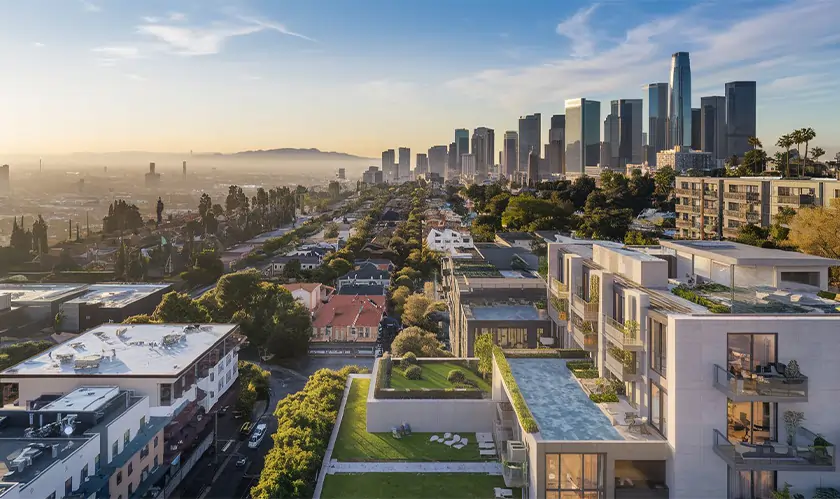Home Industry Architecture and interior design How Architecture Firms in Los ...
Architecture And Interior Design

CIO Bulletin
11 December, 2024
Los Angeles, with its vibrant energy and ever-growing population, offers many exciting opportunities for new residents. But one challenge of city living is the relentless noise—traffic, construction, and the hum of urban life. For architecture firms, designing homes that offer more than just a sleek look has become essential. With more people seeking a peaceful retreat from the constant buzz of the city, the challenge now is to create homes that balance style with serenity.
To rethink residential design, architects must shift their focus beyond aesthetics. Sound is becoming a key element of design, as architects incorporate soundproofing techniques and thoughtful layouts to create quiet, restful spaces. By focusing on noise reduction, architects can improve residents’ well-being, turning homes into peaceful havens despite the surrounding urban activity.
Urban noise in cities like Los Angeles is a common challenge for residential designs, but it doesn't have to impact quality of life. More and more of the best architecture firms are focusing on creating homes that do more than look good—they aim to offer peaceful escapes from the constant city noise. By using soundproofing methods, natural barriers, and smart space planning, architects can create peaceful environments.
Whether it’s through acoustic materials, careful building placement, or adding green spaces, these design strategies help residents enjoy calm living spaces despite the city's hustle. This approach not only improves quality of life but also highlights how architecture is progressing to support comfort and well-being.
To reduce urban noise, sound isolation techniques are vital. Architects use a variety of materials and insulation to block unwanted sound. The type of windows, walls, and floors chosen is central in stopping sound from passing through. Double or triple-pane windows provide significant sound reduction, while acoustic panels in key areas help make spaces quieter.
Insulation materials like fibrous composites or mass-loaded vinyl prevent noise from entering living areas. Design choices also play a big role in minimizing noise. For example, building orientation can place bedrooms away from busy streets. Landscaping features like earth mounds or thick plants can act as additional sound barriers.
Incorporating noise-reducing features into outdoor spaces requires a thoughtful approach to how elements interact with the environment. Beyond simple barriers, architects use various techniques to reduce outdoor noise infiltration while enhancing the aesthetics and functionality of the space. This can include using sound-absorbing surfaces like gravel paths or decks, and strategically placing water features such as fountains or ponds to mask background noise with soothing sounds.
Additionally, the choice of materials in outdoor furniture and flooring—like rubberized or cork surfaces—can absorb sound rather than reflect it. The layout of the space itself is essential, ensuring that elements like pergolas, green walls, and trellises are not only visually pleasing but also serve a functional role in breaking the flow of sound.
Nature is a great ally in reducing urban noise. Architects often use trees, shrubs, and other plants to create natural sound barriers. These features not only cut down on noise but also improve the look of residential properties. Well-placed vegetation can absorb, deflect, and scatter sound, making for a quieter living space. Thick plants can block out nearby noises like traffic or construction.
Different trees and shrubs provide different levels of sound protection. Evergreen trees offer year-round coverage, while deciduous trees are great for blocking sound during the warmer months. Layering plants can strengthen the sound barrier, creating a dense green wall around homes. Adding features like earth berms and strategically placed fences can further boost these natural barriers.
Understanding how residents feel about noise is key to shaping good design. Architects are increasingly asking for feedback from communities before finalizing residential projects. This input helps them comprehend the unique noise concerns of different neighborhoods. Surveys, workshops, and casual conversations provide valuable insights into how noise affects daily life. Residents often point out specific noise sources, like traffic or construction, which helps architects find ways to reduce these disturbances.
By involving the community, architects can make sure designs meet the needs of the people who will live there. Collaboration builds trust and guarantees homes are designed for comfort and peace. Listening to residents allows architects to add features that address noise directly, such as thoughtful layouts or sound-absorbing materials.
Architecture firms in Los Angeles are increasingly designing homes that focus on creating peace and quiet amid the city’s noise. By using soundproofing techniques, natural barriers, and outdoor noise-reducing elements, architects are turning homes into calm retreats from the urban rush. Smart choices in materials, layout, and community feedback help make these designs not only more attractive but also more comfortable and healthy. As architects keep coming up with new ways to reduce noise, they’re making city living less chaotic and more peaceful, giving residents the best of both worlds—peace and energy. This approach shows how architecture can improve life, even in the busiest cities.







